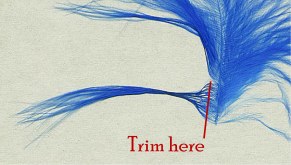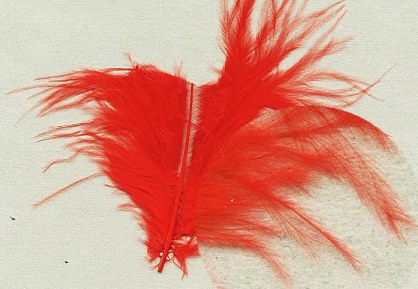Invicta Flies - Marabou Wings

Get a package of marabou and look through the individual feathers. You will see there are usually three different types, mainly contrasting in the nature of the tips of the fibers. One kind will have fibers which all terminate in a long fine tip. Another kind will have fibers with tips that end with the same "fluffiness" that is found near the base. Yet another type will have both, fluffy-ended fibers near the base, and long fine tipped fibers near the top of the feather.
The uses for marabou in fly-tying are seemingly endless. I won't try to cover them all here, just illustrate some places I feel certain methods are relevent to the pattern being tied. One use that I will not cover, but will mention due to its effectiveness, is Rene Harrop's use of marabou (with the fine tips, as shown in the above photo) for parachute posts and dry fly wings. This technique is illustrated in Fly Fisherman magazine, the September 1997 issue.
Long & Fine

This type of marabou is the best kind for marabou streamer wings, like that found on the Royo or Water Sprite. Most marabou wing streamers are tied to represent the slim, tapered bodies of many baitfish. To maximize the effectiveness of this material, there are some simple tricks:
1.) Keep the number of fibers used down to a minimum (too many and fly becomes bulky, does not fish right, and does not act right in the water; too few and the pattern looses its profile).
2.) Clip the bundle of fibers from the side of feather. Some techniques illustrate bundling up the entire top of the feather where the tips are even. This may be easy, but results in a misshapen fly, especially in the water, due to the natural angles of the fiber/stem connection. A little water will help you gather the fibers together. Stroke them away from the stem at a 90 degree angle, or until the tips are somewhat even. Why somewhat and not exactly? When fished, a streamer with marabou wing fiber tips all the exact same length looks like a "Fry Guy" or cheerleader's pom-pom, especially when fished slow. If the tips are not quite even, the wing tapers, or at least the illusion is there of a tapered body, making it more effective as a baitfish imitation. If more fibers are needed for a fuller wing or larger pattern, simply clip two or three bundles and lay them next to each other, easy to do when the fibers are still wet.
3.) This type of marabou can also be used for the short tail on streamers like the Black-Nosed Dace. Here is where you want to even up the tips as much as possible. The method of using the very top of the feather and gathering the fibers applies nicely here.
Short & Fluffy

The photo at left shows the typical base of most marabou feathers. The bottom right corner is magnified to show the tips of the fibers. This type of marabou is ideal for large nymph patterns and small streamers as on Marabou Muddlers or the Glassbead M.O.E. Clip from the stem as illustrated above, evening up the ends somewhat. Again, a little water helps with this process.